| George Washington â Father of our Country â but father of the American Mule as well? Yes, George Washington is often given credit as the first mule breeder in the Americas, although a few sources will cite otherwise. It is a fact that General George was given two fine Spanish Jacks, one dubbed âRoyal Giftâ. This animal, so eagerly awaited for the production of mules, had not, apparently, been trained to serve mares. Modern breeders with jennet jacks or mule jacks will understand quite well that Royal Giftâs mares were covered the first year by an Arabian horse stallion who was more than willing to take his place.
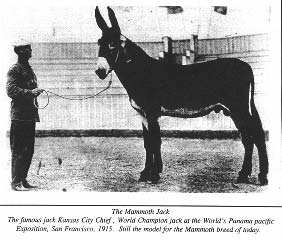 The following season, Royal Gift was helped to his duty with the use of a few jennets, and the American Mule was on its way. This jack was much in demand, and eventually toured the southern states, siring mule foals all the way. But of course, one jack could not sire all the mules in the country, and no one breed of donkey is used today in the production of mules. Todayâs Mammoth Jackstock is a blend of a number of different breeds, some with strikingly different characteristics. The following season, Royal Gift was helped to his duty with the use of a few jennets, and the American Mule was on its way. This jack was much in demand, and eventually toured the southern states, siring mule foals all the way. But of course, one jack could not sire all the mules in the country, and no one breed of donkey is used today in the production of mules. Todayâs Mammoth Jackstock is a blend of a number of different breeds, some with strikingly different characteristics.
A breed is defined as a specific type of equine with similar characteristics. If two members of the same breed are mated, the result is another is another purebred with the same body type, coloration, etc. There are no longer any real populations of true donkey breeds in the United States. The registries are bound by size, not breed type. A few small populations of endangered or ârebredâ breeds survive worldwide, but their blood can be found blended in the donkeys classified as Miniature, Standard, Large Standard, and Mammoth in the U.S.
The distinct body types and characteristics of some of the now-lost breeds can be easily seen in the Mammoth jackstock of today. The fine-boned, black Majorcan type, or the heavy-boned, dappled Andalusian can be seen side by side in the show ring. Depending on the preference of the owner, both of these types of jackstock can sire excellent mules for a number of uses.
All known former breeds of donkeys have made a contribution to the Mammoth at one time or another. Although the Mammoth is still determined by size, breeding for characteristic and type can be achieved by breeding like animals to attain a certain look. Many breeders are no longer familiar with the types used to produce the gentle giant, but occasionally an advertisement will state âCatalonian Jackâ or âAndalusian Jackâ. These should be carefully examined for pedigree, for with a solid recorded background, these animals are merely of Catalonian or Andalusian type, and should not claim that bloodline. In a noted example, the long shaggy coat of the Poitou is so dominant a trait that a 1/10th Poitou animal may have as heavy a coat as a purebred, although lacking in bone.
By the beginning of the 20th century, Mammoth jack breeders had combined the breeds available to produce a type of jack specifically for the production of mules. Today, the types are being used once again for different purposes, instead of continuing the blend into the perfect specimen. The tall, slender black jack may be used for saddle mules, and the heavy-boned, drafty dappled red roan used for draft mules.
To be listed as Mammoth Jackstock, the jack should stand 56â and taller, the jennet 54â and taller. The tallest known Mammoth stood 17 hands, although this animal only lived to the age of three. Color is not an issue, although black or sorrel (or dappled red roan) jacks are favored in draft mule production. The gray-dun (slate) color prevalent in the smaller donkey types is not favored, although it can be seen. Even large spotted Mammoths are being used to produce spotted saddle mules. No matter the height or color, the Mammoth breeding jack should be a superb specimen, with good proportion and sufficient bone to be in balance.
A frequent fault found in Mammoths is long back, with small hips and weak loins. The hip of the donkey is already smaller in proportion to that of a horse, and this fault seems to go with other body types in some cases. Jacks used for jackstock production should be the absolute best specimens available. Those used exclusively for mule production may be forgiven some flaws, but conformation can affect performance, especially in the working of the âpower train,â the hind end.
There are five main breeds that were incorporated into the development of the Mammoth jack of today: the Andalusian, Catalonian, Majorcan, Maltese, and Poitou. The gray-dun and spotted influence most likely came from Standard breeding, since the original breeds did not include these colors.
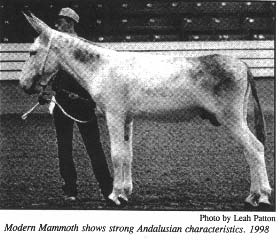 The Andalusian The Andalusian
This donkey was the drafty, heavy-boned, dappled animal. Most of the original animals imported into the U.S. (even up into the 1900âs) were dappled gray-roan (sometimes called blue roan) or red roan. The average height of the Andalusian was 14.2-15hh. Many of the heavy sorrel jacks used in draft mule breeding resemble the purebred Andalusian quite closely. The head should be in proportion, but this is the breed most likely to have a thick jaw, and Roman-type nose. The bone was heavy especially through the leg, and breeders wishing for a heavier type of jack should look to this type to add substance in both jackstock and mules. Most jacks today that exhibit the Andalusian characteristics are sorrel or dappled red roan, with little or no visible cross being preferred.
Â
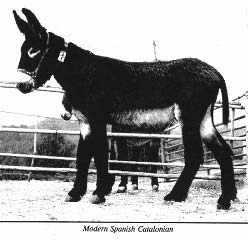 The Catalonian The Catalonian
This was one of the most popular breeds for use in creating American jackstock. The purebred Catalonian was always black, no grays or roans were ever allowed. The haircoat was fine, short and glossy. The Catalonian was finer-boned and used exclusively in Spain for the production of mules. This breed became the one of choice when creating the Mammoth, even though the average height was only 15 hands and the bone was finer and lighter than that of other jackstock breeds. Today a very tiny population of Spanish Catalonians still exists in Spain, and another small Mexican Catalonian population as well.
Majorcan
The Majorcan jack, also of Spain, was often crossed with the smaller Catalonian to produce a superb breeding jack. Black in color, although not quite with the fine-textured haircoat of the Catalonian, these jacks contributed size and bone to the Mammoth. They were often described as âsluggishâ in disposition, but there is also the possibility that they were some of the largest jackstock in existence. The demand for these huge animals quickly depleted the supply and there are no known populations of this breed today.
Maltese
From the Island of Malta, early jackstock breeders purchased every animal with any hope of breeding quality, including those whom it was hoped would grow taller. Most did not, and the animals as a breed were less than 14 hands tall. They were often a clean black, and their manner described as having extreme vigor and vitality.
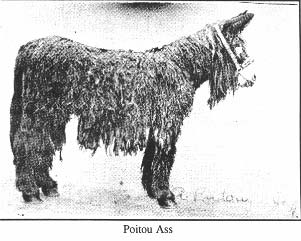 Poitou Poitou
Probably the most striking of the jackstock breeds, the Poitou survives today as an endangered breed. It is felt by some jackstock historians that the Poitou was used far less in the production of todayâs Mammoth than it should have been. The Poitou is found in France (although evidence supports they were bred from Spanish stock many centuries ago), and was used almost exclusively for the production of mules. Bred to an incredibly heavy draft horse breed called the Mulassier, mules believed to be some of the finest work and draft animals in the world were produced.
The Poitou is noted for the heavy bone, and memorably, for the long tangled coat, forming dreadlocks to the ground. The coat color is exclusively black or dark brown (termed bai-brun by the French) and should never bear a cross or stripe. This horrific coat, matted with filth and yearsâ worth of shed hair caught year after year, was prized (!) and said to be a symbol of purity in the breed.
A few Poitous were exported for breeding, and early engravings of these noted animals show them with shaggy, yet neat, coats. It is suggested that these jacks lacked the matted coat and were penalized in France. Those that were used in jackstock production contributed bone to the Mammoth, not only in leg, but in the length of the back and distinctive shape to the face.
Cost of transporting jacks to the United States, as well as the high cost of the animals themselves, may have contributed to the fact that these jacks did not play as large a role as they could have in Mammoth production. If greater numbers had been available, or transportation easier, the Poitou might have further shaped American Mammoths. There are less than 200 purebred Poitous left in the world, and the Poitou Mule has become almost extinct.
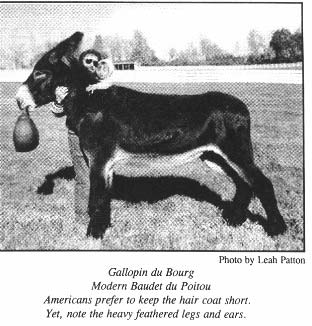 Todayâs Mammoth Todayâs Mammoth
Although todayâs Mammoth is a blend of these breeds, and certainly of even Standard donkeys of unknown origin (the spotted and dominant gray-dun influence), he is a far cry from the first mule sire, which was probably a Syrian Wild Ass. Mules in Biblical times were vastly different from the wide range of types and sizes enjoyed by the longear fancier of today.
The modern mule breeder can take a jack of any color from black to sorrel to dappled to spotted and breed to quality mares of any imaginable breed, and produce a mule suited for any type of work or use. Draft mule breeders may prefer the matched blonde sorrel in their mule, but the saddle mule owner can selectively try for spotted, dun, white, dapple gray, bay, palomino, or even colors and patterns unique to that marvelous mule. Choose jackstock wisely, regardless of color, and the mules of tomorrow can be assured of a place in the public eye as animals more worthy of praise than of âold wivesâ talesâ. With support and care, the mule and the mule jack are outgrowing old stereotypes and taking their place alongside developed horse breeds as the Equine of Choice!
|
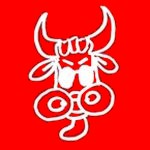

Afegeix-hi un comentari: